 |
 |
Mysterious Plane Crashes
by Lexi Krock
In the year 1020, Oliver of Malmesbury, attempting to fly, donned a homemade
pair of wings and leapt from the top of an English abbey. He broke both his
legs. Though humans have harbored the sometimes perilous dream of flying for
millennia, they succeeded in achieving sustained flight only in the past
century. In the nearly 100 years since Orville Wright's first shaky, 12-second
aircraft flight at Kitty Hawk, North Carolina, airplane travel has become a way
of life, allowing millions of people each day to zigzag from coast to coast and
continent to continent at greater speeds and higher levels of comfort and
safety than ever before.
Though relatively rare, incidents of airplane tragedy make up a significant
element of 20th century aviation history. Studying the cause of air
disasters helps engineers design safer planes and prompts officials to initiate
better air travel guidelines, yet a number of crashes have remained unsolved.
In this illustrated timeline, follow a century's worth of mysterious plane
crashes, from Orville Wright's ill-fated flight of September 1908 to the
October 1999 crash of EgyptAir flight 990.
|
|
|
|
|  Rescue workers try to free Lt. Selfridge from the wreckage in Fort Meyer, VA. Though Selfridge was killed in the accident, Orville Wright suffered only broken bones.
Rescue workers try to free Lt. Selfridge from the wreckage in Fort Meyer, VA. Though Selfridge was killed in the accident, Orville Wright suffered only broken bones.
|
September 17, 1908
Over Fort Meyer, Virginia, Orville Wright's co-pilot H. Thomas Selfridge was killed
when their plane plummeted from the sky. Wright suffered only a broken leg and
hip. For nearly a decade, the exact cause of the crash remained undetermined.
Then the plane's shattered propellor turned up, revealing the structural
failure that probably brought the early aircraft down.
| 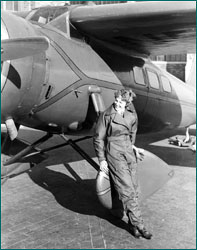 Amelia Earhart (1898-1937) and her plane
Amelia Earhart (1898-1937) and her plane
|
July 2, 1937
In 1932 Amelia Earhart became the first woman to fly solo across the Atlantic.
Emboldened by this accomplishment, Earhart set out to fly around the world in
1937. With more than two thirds of the journey completed, the twin-engine
Lockheed Electra carrying Earhart and her navigator, Fred Noonan, disappeared
near Howland Island in the central Pacific. Despite an intense investigation in
1937 and decades of subsequent speculation, the cause and location of the crash
remain unknown.
|  We will probably never know the cause of the mysterious disappearance of five Navy Avenger bombers on December 5, 1945, over this region of the Atlantic Ocean.
We will probably never know the cause of the mysterious disappearance of five Navy Avenger bombers on December 5, 1945, over this region of the Atlantic Ocean.
|
December 5, 1945
In the event that launched the so-called Bermuda Triangle legend in earnest,
five Navy Avenger bombers mysteriously vanished while on a routine training
mission, as did a rescue plane sent to search for them. In all, six aircraft
and 26 men were lost without a trace somewhere within the vast, three-sided
segment of the Atlantic Ocean. No fewer than 200 prior and subsequent
mysterious airplane and boat losses have occurred in the Bermuda Triangle.
Though theories abound about everything from strange magnetic fields to
ancient curses, no evidence has appeared that would convincingly suggest these
events were anything more than coincidence.
| 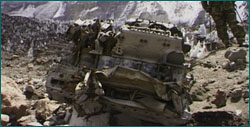 After mountaineers discovered mangled sections of an old airplane in the Andes in 1998, authorities reopened the investigation into the loss of Stardust.
After mountaineers discovered mangled sections of an old airplane in the Andes in 1998, authorities reopened the investigation into the loss of Stardust.
|
August 2, 1947
A civilian version of the Lancaster bomber named Stardust disappeared over
the Andes Mountains shortly before it was scheduled to land in Santiago, Chile.
Minutes or even moments before the plane's tragic end, its radio operator
tapped out a final, mysterious Morse code message: "STENDEC." For half a
century following the disappearance, no trace of the aircraft or the 11 people
on board was found. Then, in 1998, climbers high in the Andes discovered
fragments of the plane coughed up by a glacier. Investigators now speculate
that Stardust's navigator, not knowing that the newly identified jet stream
could slow westward-flying planes, called for the plane's descent too early,
before it had safely cleared the cloud-covered Andes. But the meaning of the
flight's last radio transmission remains unknown
(see Solve the Mystery of STENDEC).
| 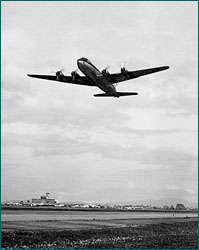 A Douglass DC-6A during takeoff
A Douglass DC-6A during takeoff
|
July 12, 1953
On its way from Guam to Honolulu, Hawaii, a Transocean Air Lines (U.S.)
Douglass DC-6A crashed at night approximately 350 miles east of Wake Island.
Searchers turned up only a small amount of debris and 14 bodies out of the 58
total people aboard. Investigators found no evidence of sabotage or an
in-flight fire, but the lack of sufficient evidence kept them from ever
identifying the true cause of the disaster.
| 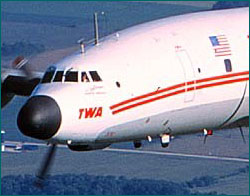 The Lockheed 1049H Super like this one that went down on March 16, 1962, was carrying 93 U.S. and three South Vietnamese service personnel plus a civilian crew of 11 Americans.
The Lockheed 1049H Super like this one that went down on March 16, 1962, was carrying 93 U.S. and three South Vietnamese service personnel plus a civilian crew of 11 Americans.
|
March 16, 1962
A four-engine Lockheed 1049H Super operated by The Flying Tiger Line (U.S.)
failed to arrive at its destination near Manila. Traveling in darkness but in
good weather conditions, the plane had simply vanished in the Philippine Sea.
Its final radio transmission gave no indication of difficulty. A week-long
search encompassing 114,000 square miles of ocean failed to turn up any trace
of the plane or its 107 passengers, and investigators never determined the
cause of the crash.
|  An Aeroflot Ilyushin I1-18B
An Aeroflot Ilyushin I1-18B
|
October 1, 1972
All 109 people aboard were killed when an Aeroflot (Russian) Ilyushin Il-18B
crashed into the Black Sea shortly after taking off from Alder on its way to
Moscow. The accident occurred in good weather and visibility, and ground
controllers received no distress message prior to the crash. An investigation
failed to reveal its cause.
|  Shortly after the pilot of South Africa Airways Flight 295 reported the presence of smoke in the cabin, he declared an emergency, radioing "Now we have lost a lot of electrics. We haven't got anything on the aircraft now."
Shortly after the pilot of South Africa Airways Flight 295 reported the presence of smoke in the cabin, he declared an emergency, radioing "Now we have lost a lot of electrics. We haven't got anything on the aircraft now."
|
November 28, 1987
Traveling from Taipei, Taiwan to Johannesburg, South Africa, South African
Airways Flight 295 flew without incident for nine and a half hours before
tragedy struck. As the Boeing 747 flew over Mauritius in the middle of the
Indian Ocean, the pilot reported smoke in the cabin. A few minutes later, the
plane crashed into the ocean, killing all 159 passengers and crew. Debris washed ashore
on the beaches of Madagascar but could not be retrieved due to political
troubles between that island nation and South Africa at the time. To this day,
the precise cause of the accident remains shrouded in mystery.
| 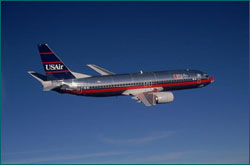 USAir Flight 427 was a Boeing 737 like this one.
USAir Flight 427 was a Boeing 737 like this one.
|
September 8, 1994
The crash of U.S. Air flight 427 near Aliquippa, Pennsylvania is one of the
worst U.S. airline disasters still assigned to the unexplained category. All
132 people aboard (126 passengers and a crew of six) perished when the Boeing
737 mysteriously plunged to the ground while preparing to make a stop at
Pittsburgh International Airport while en route from Chicago to West Palm
Beach, Florida. A five-month study by the Federal Aviation Administration
failed to reveal even a single clue to the cause of the disaster.
| 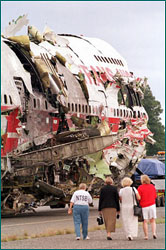 A National Transportation Safety Board official walks with three family members of TWA Flight 800 victims near the wrecked plane's partially reconstructed fuselage.
A National Transportation Safety Board official walks with three family members of TWA Flight 800 victims near the wrecked plane's partially reconstructed fuselage.
|
July 17, 1996
TWA Flight 800 exploded not long after takeoff en route from New York to Paris.
All 230 people aboard the Boeing 747 died. A range of unofficial theories as to
the cause of the crash have been advanced over the years, including the notion
that the plane was brought down by one or more shoulder-launched missiles. (A
Saudi Arabian Airlines crew did report seeing a bright greenish object
streaking by their plane not far from the Flight 800 crash site just seconds
before the TWA flight met its demise.) For its part, the National
Transportation Safety Board determined in August 2000 that a fuel-air explosion
took place inside the center wing tank, precipitating the crash.
| 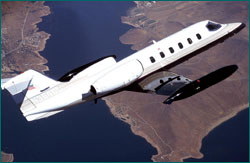 A Learjet 35 in flight
A Learjet 35 in flight
|
October 25, 1999
The tragic crash of the Learjet carrying golf champion Payne Stewart and five
other people near Mina, South Dakota will go down as one of the eeriest plane
crashes in history. The plane fell straight down into a field after flying over
1,000 miles on autopilot and then running out of gas. Approximately 30 minutes
after the Learjet 35 left Orlando, Florida on its way to Dallas, flight
controllers lost radio contact with the pilot. Though the plane climbed to
altitude and continued flying, officials suspect (but could not prove) that
rapid and complete depressurization rendered the passengers and crew
unconscious hours before the plane finally crashed, killing everyone
aboard.
|  The U.S. Coast Guard collects debris from EgyptAir Flight 990 near Nantucket Island, MA.
The U.S. Coast Guard collects debris from EgyptAir Flight 990 near Nantucket Island, MA.
|
October 31, 1999
About 1:50 a.m. EgyptAir flight 990 crashed into the Atlantic Ocean just south
of Nantucket Island, off Massachusetts. The airplane involved was a Boeing 767,
and all 217 aboard were lost. Investigators have speculated that the flight's
relief co-captain, First Officer Gamil El Batouty, was suicidal and
deliberately took the plane down, but this theory remains unsubstantiated.
Examination of the wreckage turned up few clues as to why the plane suddenly
plummeted into the ocean.
Lexi Krock is editorial assistant of NOVA Online.
Photos: (1, 5) Museum of Flight Archives;
(2, 3) Corbis Images;
(4) BBC/Horizon;
(6) Lawrence Feir;
(7) Rykoff Collection;
(8, 9, 11) George Hall/Corbis Images;
(10, 12) AFP/Corbis Images.
Solve the Mystery of STENDEC |
Mysterious Plane Crashes
Reading the Wreckage |
Inside the Jet Stream |
Resources
Transcript |
Site Map |
Vanished! Home
Editor's Picks |
Previous Sites |
Join Us/E-mail |
TV/Web Schedule
About NOVA |
Teachers |
Site Map |
Shop |
Jobs |
Search |
To print
PBS Online |
NOVA Online |
WGBH
© | Updated January 2001
|
|
|